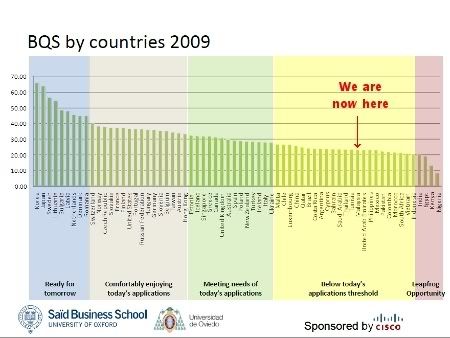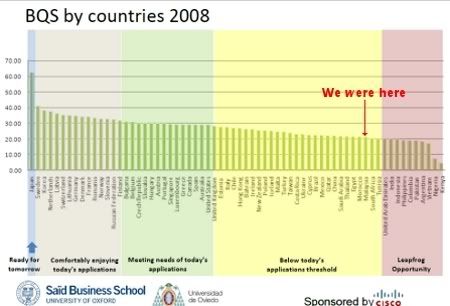If you have problems reading this...
Technorati tags: Technology, IT, Broadband Quality, Internet
… this is probably why.
 Yes, a new study by Oxford University, in collaboration with Cisco, has rated us a not-too-great #48 in terms of broadband quality, as reported by The Malaysian Insider today.
Yes, a new study by Oxford University, in collaboration with Cisco, has rated us a not-too-great #48 in terms of broadband quality, as reported by The Malaysian Insider today.
What the report does is officially documenting something Malaysian Internet users are already painfully aware of – that our broadband isn’t all that broad.
Walski urges you to take some time to look at the actual report, which can be viewed here (via the Oxford Said Business School website).
Malaysia’s relatively low ranking, among the countries included in the study, may be telling in itself. But it doesn’t tell the whole story – which, unfortunately, is sadder than simply the ranking.
While the emphasis area that we keep hearing from the government is penetration, i.e. the percentage of households with broadband access, the Broadband Quality isn’t simply about how many people have access to services.
There is, in fact a lot more to Broadband Quality – like data throughput and latency – something that many Internet users in Malaysia can tell you is definitely not up to snuff.
(factors in the study, and more, in the full post)
The main focus of the study, from what Walski gathers, is how broadband services worldwide are coping with the applications being accessed today, and how future ready they are on the demands of the future.
And it is this area that Malaysia fares not very well, ranking in the region of “Below today’s application threshold”.
Compared to last year’s inaugural study, we have improved. However, the parameters governing the measurements have also changed, namely the threshold values determining adequacy for now, and for the future.
In essence, the report uses the following main broadband quality parameters (derived from the report, downloadable from here):
- Download throughput – the net bitrate of downstream data. This criterion is important for effective streaming of high quality video and sharing of large files (increasingly important in collaborative across the ‘Net endeavors)
- Upload throughput – the net bitrate of upstream data. This criterion plays an important part in sharing and uploading of image/video, and 2-way high quality video communications
- Latency – time taken for data packets to travel from source to destination. This criteria is important for real-time applications, such as Voice over IP (VoIP)
- Other criteria taken into consideration include network oversubscription, data packet loss, jitter (measure of latency variation over time), service continuity, etc.
In other words, the report looks at much more than just penetration. One factor that has been introduced into the 2009 report is the disparity of Broadband Quality Score (BQS) between urban and non-urban areas within a given country. This is one area where Malaysia scores rather low – meaning that there is not much of discernible difference of quality between urban and non-urban areas. Which is still not a good thing, because what it implies is that the quality is pretty low throughout.
Some apologists might view this report, particularly when it comes to Malaysia’s placing, as the West trying to undermine our country’s efforts in IT proliferation. If one were to actually read the report, however, it can easily be ascertained that this is definitely not the case. In fact, 4 out of the top 10 countries on the list are in Asia, with the top 3 being South Korea, Japan and Hong Kong (in order of ranking).
There is also an implicit link between broadband quality and the economic focus of a given country. If Malaysia wants to transition towards becoming a more high-value, technologically driven economy, the availability of a world-class communications infrastructure becomes an important factor. Apart, of course, from a world-class education system – another area where much is left to be desired.
The question on the minds of many Malaysians, Walski included is this: how is it that Malaysia has fared so badly despite the fact that the MSC (Multimedia Super Corridor), launched in 1986, was supposed to propel Malaysia prominently into the world of IT? 13 years later, we’re still talking about broadband penetration (currently at around 26% or thereabouts) as being the key benchmark, and not about other more important factors, such as quality of service.
Apart from a quantitative analysis, the report also provides some broad recommendations to countries in how improvements can be realized. Some of these recommendations include (emphasis by myAsylum):
- Set national broadband agenda with goals for availability, penetration and quality.
- Provide content and applications that are quality-aware to ensure a consistent customer experience
- Build a broadband business model based on quality as the key differentiator
Any Malaysian broadband user that has used similar services abroad will immediately realize that something is amiss with the level of quality provided within Malaysia. It is, in fact, glaringly obvious sometimes, as Walski has discovered. “Best Effort” is simply no longer good enough a promise that an increasingly globally-aware Malaysian population will put up with.
What he wonders, though, is if the right criteria are being looked at, as we strive for improvement. So far, it seems that penetration, and penetration alone, is the focus, implying that if our target is met (50% by 2010), we’ll still be playing catch-up in other, more critical areas.




![Reblog this post [with Zemanta]](http://img.zemanta.com/reblog_e.png?x-id=25b1ab0f-cc5f-454f-b180-eca5c3618944)














